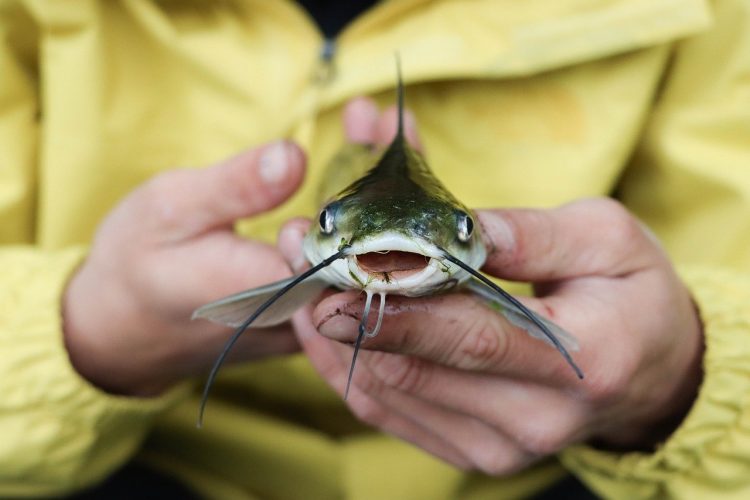Catfish are one of the most intriguing fish species that people know of, and they are also very abundant in nature since more than 3,000 species are found worldwide except in Antarctica. Like all other fish, catfish are cold-blooded, which is why temperature plays such an essential part in this fish’s life.
How important is the temperature for catfish?
Since catfish are cold-blooded, the water temperature dramatically affects the quality of life. Unlike humans, their bodies cannot adjust their temperature regardless of the extreme temperature. Since there are so many different types of catfish, there are many different temperatures that a catfish lives in. However, most catfish prefer warmer water. All phases of life of catfish directly depend on the temperature of the water. The most important thing that depends on temperature is the breeding of the fish. They start spawning when the temperature reaches around 70 F. If not, the fish will not spawn and will not produce offspring. Here is the importance of temperature in the life of catfish.
The oxygen level
When the water is warm, less oxygen dissolves because the water molecules move at a warmer temperature. As a result, the molecules absorb less oxygen. The catfish can breathe because of the oxygen that enters their bloodstreams after the water passes through their gills.
If the temperature is too high, the fish will not get enough oxygen, and as a result, it will not be able to breathe. There is always a critical temperature, above that, the fish die because they cannot live. The highest critical temperature for catfish is 104 F, and the lowest temperature is 36 F.
The metabolism rate
Temperature plays a significant role in metabolism as well. The water temperature cannot get too high or too low, or it can shorten the fish’s lifespan.
When the temperature is too high, the fish’s metabolism is high, so it is very active and wants to eat more food. Metabolism is the rate at which food is converted into energy. In fact, a fish’s metabolic rate doubles for every 10 degrees Celsius that the water temperature increases. When the metabolism increases, the fish needs more oxygen, and the fish is not getting that, so it can be bad for the fish. On the other hand, if the temperature is too low, the metabolism rate is too low. Therefore, the fish will be sluggish and not eat any food or swim.

Reproduction of the fish
As mentioned above, each fish has a specific temperature at which it spawns. If the temperature is not correct, the fish will not reproduce. Since catfish are cold-blooded, they need a high temperature to spawn, and if this temperature is not reached, their numbers will dwindle. In the wild, the fish often migrate to another place if the area no longer has the perfect temperature for spawning.
The mortality and morbidity
When the temperature of the fish is too high, it also affects mortality. One reason is that when the metabolism is high, the fish needs more oxygen; if it doesn’t get it, it can die. Moreover, more toxic substances in warm water can become soluble, like nitrate and ammonia, which are very bad for fish. These soluble chemicals at a high concentration can kill the fish. Also, there is more growth of harmful bacteria and fungus, which can again lead to various diseases and cause the fish to die. On the other hand, if the temperature is too low, there is no growth of beneficial bacteria, which is also needed for the fish. The temperature needs to be stable and just right for the fish to thrive and not die prematurely.
What affects water temperature?
Many things affect the temperature of the fish. The temperature is affected by many factors, whether in the tank at the home, aquarium, or in the wild. It is essential to know these factors to maintain the tank’s water temperature. On the other hand, fishers can use this guide to understand when to hunt for fish in the ocean. When the water is warmer, and the fish are spawning, it will be harder to catch them because they will be more aggressive. Similarly, if the water temperature gets too cold, the fish will migrate to find warmer places to swim in.
Two of these that affect the temperature of the fish and how they behave are listed below.
Sunlight
If it is in the wild or in a home tank, the outside temperature affects the temperature of the fish as well. In the wild, when the sun’s warming hours are longer, like during spring or summer solstice, the fish usually spawn. During the winter, the sun’s warming hours decrease, so no spawning occurs. In a home tank, the position of the tank matters. If it is placed near a window or direct source of the sun, the water temperature will be higher than if it is placed in a dark and shaded place.
Environment
If the country is suffering from heat waves or cold fronts, the water temperature and the internal temperature of catfish will be affected. This will again affect the behavior of the fish in the wild and at home as well. Similarly, the lighting in the tank affects the temperature as well. Light lamps produce a lot of heat, so if the tank light is on for longer periods of time, the water in the tank will be much hotter.
Conclusion
Now you know that catfish are, in fact, cold-blooded, so the temperature of the outside matters a lot in their lives.









Pingback: Do Catfish Like the Rain? | Reel Fishing Guru
Pingback: Do Catfish Hibernate? | Reel Fishing Guru
Pingback: Do Catfish Ever Stop Growing? | Reel Fishing Guru